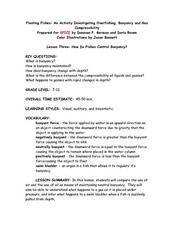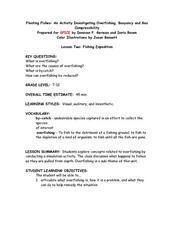Curated OER
Floating Fishes: How do Fishes Control Buoyancy?
Playing with balloons, water, oil, and bottles help put this lesson over the top! Participants use air-filled balloons in water tanks to experience gas compression. They also use oil-filled bottles to experiment with buoyancy. Included...
Curated OER
Floating Fishes: Fishing Expedition
A referenced PowerPoint is not included, but this lesson can still make an impact with emerging environmentalists. After introducing them to the facts about overfishing, they experiment with a fishing simulation using colored beads and...
Curated OER
Fishes
In this fish learning exercise, students will use fish characteristics vocabulary words to fill in the blanks of 3 statements and a crossword puzzle.
California Academy of Science
Buoyancy Bulls-Eye
Why does a seastar sink, but a jellyfish float? Through a fun investigation, learners examine the concept of buoyancy using simple household items. The challenge: create neutral buoyancy for an action figure in water. With ample teacher...
Curated OER
How Fish Maintain Neutral Buoyancy
In this buoyancy activity, students read about neutral buoyancy and that the downward force of gravity is equal and opposite to the upward force of water. They answer four critical thinking questions about buoyancy.
Curated OER
Condiment Diver: The World's Simplest Cartesian Diver
Middle schoolers examine buoyancy. In this density instructional activity students form a hypothesis, collect data and draw a conclusion using the data.







